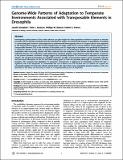Por favor, use este identificador para citar o enlazar a este item:
http://hdl.handle.net/10261/99960COMPARTIR / EXPORTAR:
 SHARE SHARE
 CORE
BASE CORE
BASE
|
|
| Visualizar otros formatos: MARC | Dublin Core | RDF | ORE | MODS | METS | DIDL | DATACITE | |

| Título: | Genome-Wide Patterns of Adaptation to Temperate Environments Associated with Transposable Elements in Drosophila |
Autor: | González Pérez, Josefa CSIC ORCID ; Karasov, Talia L.; Messe, Philipp W.; Petrov, Dmitri A. | Fecha de publicación: | 8-abr-2010 | Editor: | Public Library of Science | Citación: | PLoS Genetics 6(4): e1000905 (2010) | Resumen: | Investigating spatial patterns of loci under selection can give insight into how populations evolved in response to selective pressures and can provide monitoring tools for detecting the impact of environmental changes on populations. Drosophila is a particularly good model to study adaptation to environmental heterogeneity since it is a tropical species that originated in sub-Saharan Africa and has only recently colonized the rest of the world. There is strong evidence for the adaptive role of Transposable Elements (TEs) in the evolution of Drosophila, and TEs might play an important role specifically in adaptation to temperate climates. In this work, we analyzed the frequency of a set of putatively adaptive and putatively neutral TEs in populations with contrasting climates that were collected near the endpoints of two known latitudinal clines in Australia and North America. The contrasting results obtained for putatively adaptive and putatively neutral TEs and the consistency of the patterns between continents strongly suggest that putatively adaptive TEs are involved in adaptation to temperate climates. We integrated information on population behavior, possible environmental selective agents, and both molecular and functional information of the TEs and their nearby genes to infer the plausible phenotypic consequences of these insertions. We conclude that adaptation to temperate environments is widespread in Drosophila and that TEs play a significant role in this adaptation. It is remarkable that such a diverse set of TEs located next to a diverse set of genes are consistently adaptive to temperate climate-related factors. We argue that reverse population genomic analyses, as the one described in this work, are necessary to arrive at a comprehensive picture of adaptation. [Author Summary] The potential of geographic studies of genetic variation for the understanding of adaptation has been recognized for some time. In Drosophila, most of the available studies are based on a priori candidates giving a biased picture of the genes and traits under spatially varying selection. In this work, we performed a genome-wide scan of adaptations to temperate climates associated with Transposable Element (TE) insertions. We integrated the available information of the identified TEs and their nearby genes to provide plausible hypotheses about the phenotypic consequences of these insertions. Considering the diversity of these TEs and the variety of genes into which they are inserted, it is surprising that their adaptive effects are consistently related to temperate climate-related factors. The TEs identified in this work add substantially to the markers available to monitor the impact of climate change on populations. |
Versión del editor: | http://dx.doi.org/10.1371/journal.pgen.1000905 | URI: | http://hdl.handle.net/10261/99960 | DOI: | 10.1371/journal.pgen.1000905 | ISSN: | 1553-7390 | E-ISSN: | 1553-7404 |
| Aparece en las colecciones: | (IBE) Artículos |
Ficheros en este ítem:
| Fichero | Descripción | Tamaño | Formato | |
|---|---|---|---|---|
| genome_wide_Gonzlez.pdf | 325,12 kB | Adobe PDF |  Visualizar/Abrir |
CORE Recommender
PubMed Central
Citations
74
checked on 05-abr-2024
SCOPUSTM
Citations
117
checked on 15-abr-2024
WEB OF SCIENCETM
Citations
115
checked on 23-feb-2024
Page view(s)
343
checked on 15-abr-2024
Download(s)
198
checked on 15-abr-2024
Google ScholarTM
Check
Altmetric
Altmetric
Artículos relacionados:
NOTA: Los ítems de Digital.CSIC están protegidos por copyright, con todos los derechos reservados, a menos que se indique lo contrario.
